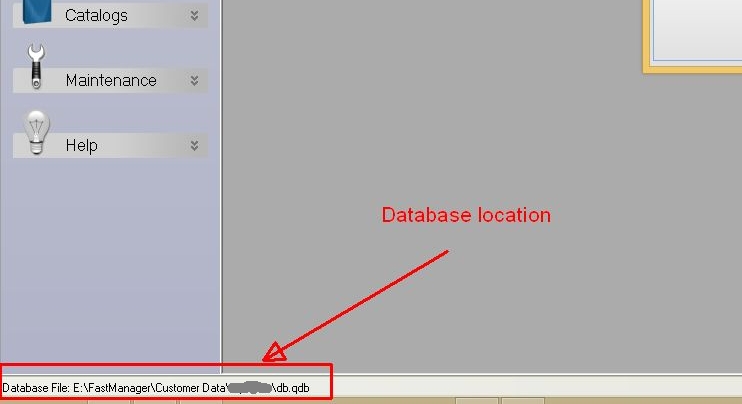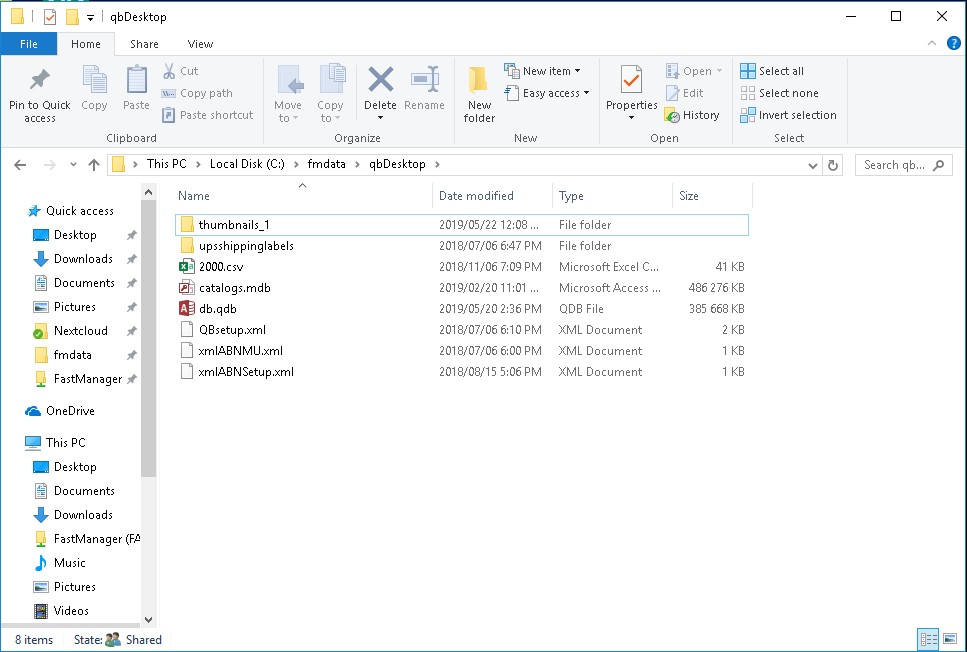Table of Contents
Maintenance
Maintaining FastManager
Your subscription to FastManager includes *unlimited* Maintenance, Support and access to any Updates that may be released from time to time.
- For more information see: Updating FastManager
If you have any questions or problems, feel free to head to the HelpDesk to get assistance
Backup your database
Therefore, you may prefer to backup just the company & catalogs databases. It's up to you. The steps are essentially the same: it's only a difference between ZIP'ing just the 2 database files and ZIP'ing the entire folder
Rather manually ZIP the databases, then move them to another folder and let that folder be included in the automated backup.
Step 1: locate your “FastManager Data Folder”
This is the folder where your company database is stored, as well as various other files and folders that FastManager uses.
- Open FastManager and check in the lower-left corner of the program window, there you will see the “path” to where your main company database is stored.
Using Windows File Explorer locate that folder. In it you will find the following files:
db.qdbcatalogs.mdb(or it might be justcatalogs)
And some folders, such as:
thumbnails_1upsshippinglabels- … and a few others.
Here is an example:
db.qdb.This is the file which contains all your customers, orders, and everything else (except your catalogs and items, those are stored seperately)
Step 2
Get everyone to close FastManager

These 2 lock files should disappear after everyone closes FastManager.
If the lock files are still there even after you are sure that FastManager is closed everywhere - contact the HelpDesk for assistance
Once are sure the “lock” files are gone - proceed to the next step:
- Press
Ctrl+A(simultaneously)) on your keyboard to select all the files & folders inside that folder.
- Or use
Ctrl+left-clickto selectively highlight only certain files.
- Select the fies:
db.qdbandcatalogs.mdb(might be listed as just:catalogs)
You can optionally also select:pictures_1 (this is your Pictures Folder, sometimes also called: thumbnails_1), but remember that this could make your backup file quite large.
- Now right-click on one of the highlighted items and select:
Send to --> Compressed (Zipped) Folder- This will zip all the selected files & folders together into one archive,
- If you're pressed for available space (the thumbnails _1 folder and the “catalogs” database can become quite large), remember that the most important thing to have a backup of, is the main company database file: 'db.qdb'
Now you should have a new file in that folder called: db.zip or, possibly: catalogs.zip.
That is your backup.
- Move or copy that
.ziparchive to some other folder, for example, if you have your own private NextCloud server, or if you're using a proprietary service such as DropBox or Carbonite, move the filedb.zipinto a folder that will be picked up by that software so that it makes a remote backup for you (uploads it to your cloud storage). - You could also copy it onto a thumb drive or other external, removable storage.
If you make a copy of a file and keep it in the same location as the original - you don't have a backup, you just have a copy.
If the hard drive fails or the building burns down, you have lost both.
Backing up a SQL database
Open “SQL Server Management Studio”
- Connect with “Windows Authentication”
- Expand
Databases
- Right-click on the database to backup
- Select/confirm the database to backup
Backup to= 'Disk'
- Click on ADD to add a new backup location & filename
- Browse to the folder where the backup file will be stored and give it a name
- (remove any unneeded entries from the list of backups to be created)
- Then click OK
Data Verification
From time to time it may become necessary to verify the data contained in the database.
Accounts Receivable Report that show 0.00 as the balance.This is often a “glitch” in the data and can be fixed with a Data Verification.
In FastManager, go to File → Data Verification
- Each option performs a different task.
- You can safely select all the options,
- Remember to check the box to confirm that all the other users have closed FastManager before you click on Start
Verify Items will take a long time (especially if you have several vendor catalogs)


